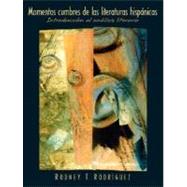
Note: Supplemental materials are not guaranteed with Rental or Used book purchases.
Purchase Benefits
What is included with this book?
Rodney Rodríguez is Professor of Spanish and Chair of the Department of Modern Languages at Manhattan College/ The College of Mount Saint Vincent in New York City. A native of Tampa, Florida, he has his undergraduate degree from Florida State University and his advanced degrees from Northwestern University (Evanston, IL). His many publications center primarily on eighteenth and nineteenth-century narrative and modern Spanish poetry. He is currently the chair of the Spanish SAT II Test Development Committee for the College Board.
| La poca Medieval | |
| Introduccion | |
| El Cantar de Mio Cid, Tirada | |
| Los milagros de nuestra seoora (XX) | |
| Las cantigas de Santa Maria (181) | |
| El Conde Lucanor (Lo que le sucedio a un mozo que se caso con una mujer de muy mal caricter) | |
| Proverbios morales (fragmento) | |
| El libro de buen amor (fragmentos) | |
| Poema XXIV | |
| El encuentro entre dos culturas | |
| Introduccion | |
| El laberinto de la soledad (fragmento) | |
| Brevisima relacion de la destruccion de las Indias (fragmento) | |
| Historia verdadera de la conquista de la Nueva Espaoa (fragmento) | |
| Los Naufragios (fragmentos) | |
| Historia general de las cosas de Nueva Espaoa (fragmento) | |
| Comentarios Reales (fragmento) | |
| El buen gobierno (fragmento) | |
| La poesia del Renacimiento | |
| Introduccion | |
| El Romancero | |
| En tanto que de rosa y azucena | |
| Subo, con tan gran peso quebrantado | |
| La vida retirada | |
| Muero porque no muero | |
| Noche oscura del alma | |
| La araucana (fragmento) | |
| A mis soledades voy | |
| La prosa ficcion del Siglo de Oro | |
| Introduccion | |
| La Celestina (fragmento) | |
| Lazarillo de Tormes | |
| Don Quijote de la Mancha (I, i-viii; xxii) | |
| El prevenido engaoado | |
| La comedia del Siglo de Oro | |
| Introduccion | |
| El burlador de Sevilla | |
| El Barroco | |
| Introduccion | |
| La dulce boca que a gustar convida y Mientras por competir con tu cabello | |
| Los sueoos (III) y Mire los muros de la patria mia | |
| El heroe (Primor I) | |
| La vida es sueoo (Soliloquios de Segismundo) | |
| A una vieja del Cuzco | |
| Hombres necios que acusiis y En perseguirme mundo, que interesas? | |
| El Romanticismo y Sus Huellas | |
| Introduccion | |
| Los caprichos | |
| En una tempestad | |
| Vuelva usted maoana | |
| Cancion de Pirata | |
| Don Juan Tenorio (3r acto) | |
| A el | |
| El matadero | |
| Martin Fierro (fragmento) | |
| El alacrin de Fray Gomez | |
| No digiis que agotado su tesoro, Yo soy ardiente, yo soy morena, y Volverin las oscuras golondrinas | |
| Cando penso que te fuches | |
| El realismo y el naturalismo y su duracion | |
| Introduccion | |
| Fortunata y Jacinta (fragmento) | |
| Las media rojas | |
| Clarin | |
| Los amores de Bentos Sagrera | |
| El desalojo | |
| El hijo | |
| De como al fin lloro Juan Pablo | |
| Pobre negro (fragmento) | |
| Los amos | |
| La poesia odernista y su inflencia | |
| Introduccion | |
| Yo soy un hombre sincero y Dos patrias | |
| Nocturno III | |
| Cancion de otooo en primavera, Sinfonia en gris mayor | |
| Table of Contents provided by Publisher. All Rights Reserved. |
The New copy of this book will include any supplemental materials advertised. Please check the title of the book to determine if it should include any access cards, study guides, lab manuals, CDs, etc.
The Used, Rental and eBook copies of this book are not guaranteed to include any supplemental materials. Typically, only the book itself is included. This is true even if the title states it includes any access cards, study guides, lab manuals, CDs, etc.